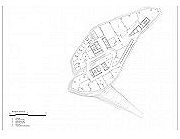As part of an occasional conversationsEAST series on major architectural developments across the globe, we take a look, in this article, at the The Jockey Club Innovation Tower (JCIT) in Hong Kong.
The JCIT is home to the Hong Kong Polytechnic University (PolyU) School of Design, and the Jockey Club Design Institute for Social Innovation.
![]() Discover the original video on Vimeo here…
Discover the original video on Vimeo here…
The Tower, designed by Zaha Hadid Architects of London, appears from one angle to be reminiscent of the prow of a great ship, cutting through the Honk Kong island landscape.
A formidable block, which at first appears to teeter or lean from its base, yet which is an elegant building, seeming to move forward, conveying a sense of motion.
The tower contains 15,000 square meters of space, and can accommodate some 1,800 students and staff. It crests at a height of 78 metres.
We think the tower is a great metaphor for an enterprising community. Hong Kong, enjoying unique relationships with Britain and China because of its history, none the less has in the Jockey Club Charitable Institute and the islands’s seats of learning, a powerful admixture to reap social and economic change in the region.
Indeed, the building’s occupants define its mission as being ‘…initiated by PolyU and the Hong Kong Jockey Club Charities Trust, Jockey Club Design Institute for Social Innovation (J.C.DISI) convenes university expertise, curates trans-disciplinary projects, and constructs partnerships for social well-being and positive systemic change’.
 Exploring the Hadid Architects web pages, the drawings of the tower, confined by the landscape the building is set in for sure, none the less look like drawings for rotational cam devices – using an engineering metaphor to illustrate the movement of all the enterprise contained within.
Exploring the Hadid Architects web pages, the drawings of the tower, confined by the landscape the building is set in for sure, none the less look like drawings for rotational cam devices – using an engineering metaphor to illustrate the movement of all the enterprise contained within.
Supporting the circular energy idea, despite the many contradictions of Hong Kong, are PolyU projects like SOCIA. Striving to co-ordinate and facilitate research and social change with the English speaking world, SOCIA looks to ‘…articulate partnership, with government, business, community and academia, for design-embedded social innovation projects – to incubate a new generation of graduates and young designers as novel thinkers, activists and change-makers from Hong Kong‘.
![]() See SOCIA and its projects on their web pages here…
See SOCIA and its projects on their web pages here…
A building is simply a shelter. In the case of Hadid’s tower it is also a shelter for ideas, community engagement, innovation and education. If the concrete construct is a metaphor for innovation, it’s enduring legacy could be substantial and durable change in the communities that lie within its hinterland?
